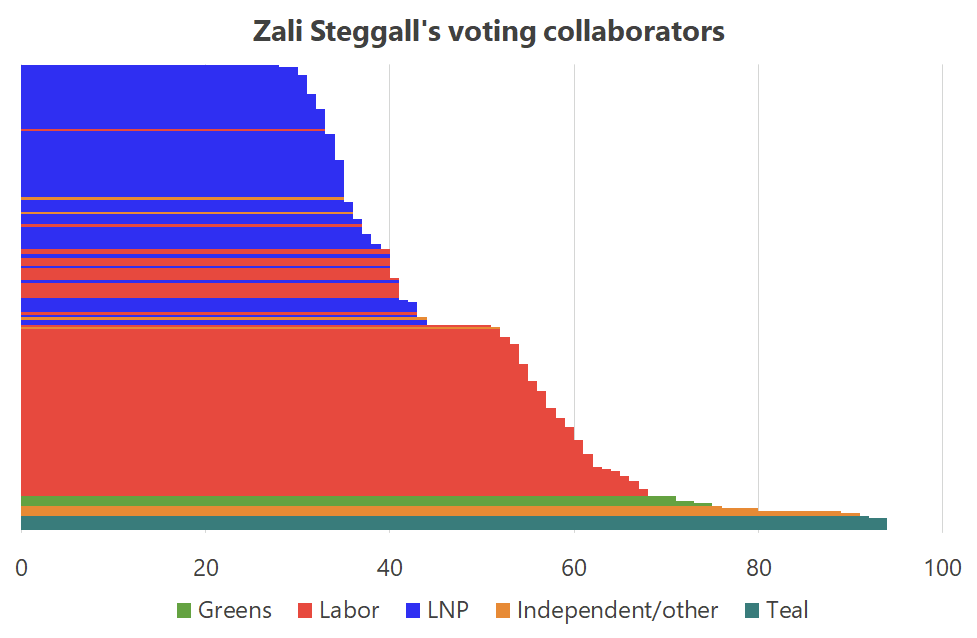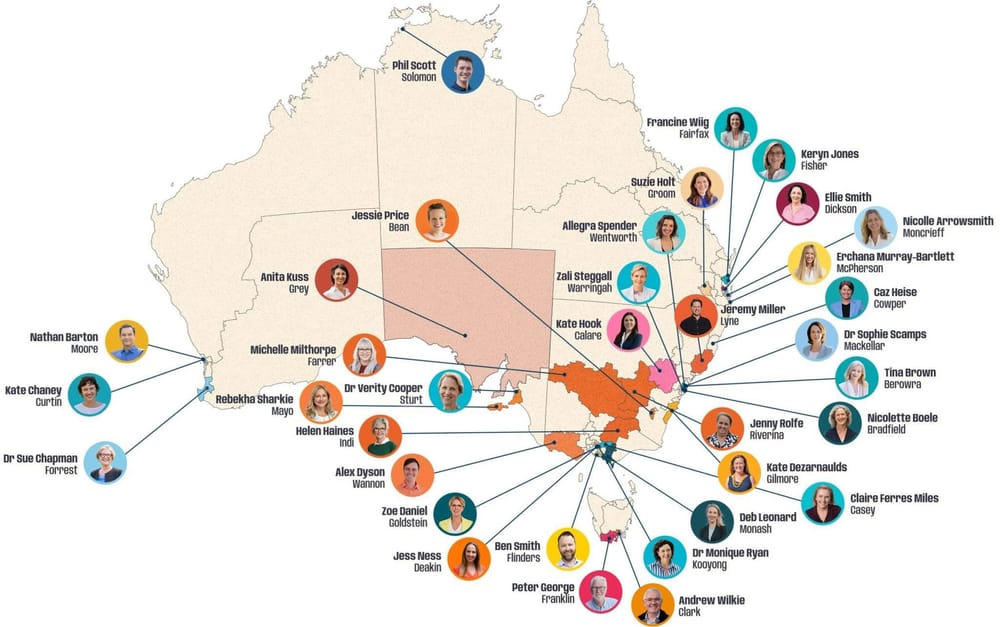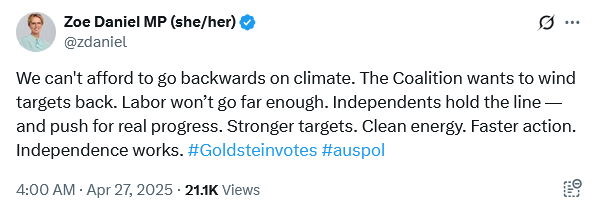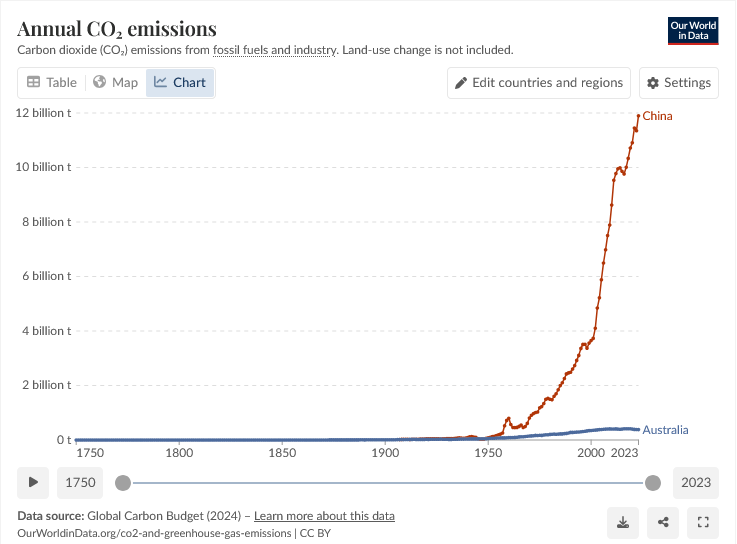Who are the Teals?
This is the third and final Deep Dive into the upcoming federal election, which is now just a couple of days away (if you missed the ones on Anthony Albanese and Peter Dutton, you can find them here and here, respectively).
This post has also been the most challenging to write: the so-called independent Teals, while aligned on most issues, also have a few important policy differences, making it difficult to paint them all with the same brush.
But given there’s a very good chance (90%) Labor wins re-election and that, if it’s as a minority government, several Teals may hold the balance of power—forcing the government to negotiate with them to get their legislation passed—then it’s probably worth learning a bit more about them!
Blue and green, or green and red?
There are seven Teals already in Parliament: Zali Steggall was elected in 2019, and was joined by Allegra Spender, Monique Ryan, Kate Chaney, Zoe Daniel, Kylea Tink, and Sophie Scamps in 2022.
All of them hold former blue-ribbon Liberal Party seats, hence the colour teal: they’re supposedly blue (i.e. hold Liberal values) but with a green tinge, reflecting their major point of differentiation—the environment.
Essentially, affluent residents of inner city electorates who were frustrated with the Liberal Party’s climate denialism but didn’t want to swing all the way across to Labor or the Greens could, with a clear conscience, vote for a Teal instead. They would then basically get a local “independent” member that would vote yes for things like solar and wind subsidies and block new coal mines, while still siding with the Liberals on more traditional conservative issues.
However, their voting records suggest that’s not how it worked out in practice. Despite not being a party, the Teals have a knack for voting in near-unison, and also tend to throw their support alongside the Greens and Labor significantly more often than they do the Liberals. I’ve shown Zali Steggall’s voting record below because she’s the only Teal to have served two terms, so has the most data available.

So, what explains the lack of unison with the Liberals given that the Teals occupy formerly blue-ribbon Liberal seats (surely there’s just not that much environmental legislation out there for them to butt heads over)?
As the saying goes, when in doubt—follow the money! Perhaps a key reason why the Teals are more Greens’ green than Liberal blue is because their advisors are mostly ex-Greens and Labor staffers, and they draw significant funding from a group called Climate 200, a political fundraising group bankrolled by the likes of Simon Holmes à Court and Atlassian co-founder Mike Cannon-Brookes.
For those unaware, Holmes à Court—the son of Australia’s first billionaire—has been active in politics for some time. Originally a member of Josh Frydenberg’s Kooyong 200 group, he was expelled after he “wrote a column for The Guardian in early 2018, which included a line criticising Frydenberg for trying to keep NSW’s Liddell [coal] power station open”.
Holmes à Court is a big investor in renewables and green tech, and frequently speaks out in public in defence of his own portfolio—and against anything that might jeopardise it, including nuclear power.
As for Mike Cannon-Brookes, he was about as green as they come until he recently decided the charade was too difficult to maintain, buying himself a private jet to make it easier to watch the Utah Jazz (which he part-owns) and the Formula 1 team he sponsors as they travel the world.
With money flowing from big-name backers like those, the Teals’ unity at the ballot box makes more sense—and their influence could grow further. Climate 200 is providing funding for at least 35 candidates in this weekend’s election (not all of them are ‘officially’ Teals) and while most will inevitably fail in their bids, if their numbers grow by even a little, then they could have significant sway over the policies of whichever major party eventually forms government.

That’s a big deal, so it’s important to know where they stand on the issues that will shape the future direction of the Australian economy.
Where they stand
Despite being independents, the Teals have a few key policies in common. You can find them plastered over their how to vote cards, or on their billboards. For example, this is on Monique Ryan’s 2025 card:
- Cost-of-living relief
- Housing affordability
- Climate action
- Integrity in government
- Education
- Health
- Tax reform
Not all of those were there in 2022, with the common themes being climate action, integrity, and the economy (which looks to have now been split out into housing, health, education, and reform).
Kate Chaney’s 2025 card is similar:
- Housing affordability
- Business and the economy
- Cost of living relief
- Climate and energy
- Cleaning up politics
- Stronger communities
You get the gist—all themes against which no one could ever object unless their heart happened to be forged in the fires of Mount Doom.
But just because you’ve identified a problem doesn’t mean your solutions will make it any better. So, let’s take a closer look at where they really stand on some of these issues.
Climate and energy
The Teals’ collective position on climate and energy was dreamt up in another era; a time of ultra-low rates that ensured governments could roll out green subsidies seemingly for free, and voters would barely blink an eye because the interest on Australia’s growing debt was perfectly manageable.
Tweets like this one essentially sum up their views on climate and energy:

But those days look to be over, and with them the green free lunch.
S&P Global Ratings is already warning that Australia’s AAA credit rating may be at risk because the “budget is already regressing to moderate deficits as public spending hits post-war highs, global trade tensions intensify, and growth slows”.
Subsidising green investments in a world with positive real interest rates is costly and has real trade-offs, and is therefore valuable only insofar as people care about the emissions-reduction benefits it brings. But when push comes to shove (what economists call revealed preferences), people just aren’t willing to pay much at all to reduce their carbon emissions.
There are many reasons as to why people might be apathetic to climate concerns, from the global free-rider problem to the fact that people know the climate doesn’t care about per capita emissions, and Australia just isn’t that big of an emitter.
In fact, if we cut our annual emissions to zero today (382.97 million tonnes), it would only take China (11.9 billion tonnes) 282 hours—less than two weeks—to completely nullify the effect. Stated differently, a 3% decline in China’s emissions would have the same effect as Australia cutting all of its emissions.

Australian households are already paying considerable sums to abate carbon emissions as part of existing state and federal policies, whether it’s directly through various environmental programs and the more than $40 billion in renewable energy subsidies (i.e. well over $4,000 per household), or indirectly through higher energy prices, which are being temporarily suppressed by cash handouts.
So, it’s understandable that Australians might not want to pay out of their own pockets to abate carbon. But what if the government paid them? Enter the Teals’ climate plan, which involves cutting carbon emissions ( 75% or more by 2035) using a combination of things like “prevent[ing] new fossil fuel projects while setting a timeline for the phased closure of existing operations”, along with heavy subsidies.
For example, most of them have some kind of home battery scheme, such as Sophie Scamps’ promise for $5,000 per household (a little more than Labor’s 30% discount on installed costs), or Allegra Spender’s plan for zero-interest loans of up to $25,000 for solar panels and batteries.
One reason why these policies (and the Teals) might be popular in their electorates is because they are regressive and will principally benefit the wealthy—i.e. many of their constituents—at the expense of lower income renters and apartment dwellers that can’t afford to live there. Worse, they’re also likely to have what’s called inframarginal effects, which is an economic term that describes the situation where a portion of a subsidy goes to people who would have purchased the subsidised good anyway, even without the incentive—a highly inefficient outcome because the policy is not effectively targeting new adopters.
So, that’s how they can have their environmental cake and eat it too: many households either aren’t aware of the true costs of their policies because they are obfuscated through dispersion (spread across all taxpayers)—or, given that Teal voters are confined to leafy green affluent suburbs, they just don’t care all that much about their less fortunate compatriots in the outer suburbs who will carry a disproportionate burden of said costs.
Affordable housing
Also at the centre of every Teal policy platform is a commitment to work towards affordable housing. The best is certainly NSW’s Allegra Spender, who recently acknowledged that “there’s still too much focus on demand side policies that just push up prices”, instead “calling for supply-side reform”.
Spender even proposed reforms that would actually achieve that, too, such as bringing “forward financial incentives under the New Homes Bonus and attach these to step by step milestones”, and improving construction productivity by creating “a new construction regulator, and immediately act on the recommendations of the Productivity Commission’s recent report”.
While she erred in suggesting a doubling of the $10 billion Housing Australia Future Fund, which is built on a flawed model of government-as-investor and is already at risk of needing to be recapitalised, it’s still better than many of her Teal colleagues.
But the Teals’ collective affordable housing credibility drops off from there. For example, Kate Chaney’s plan to “solve our housing crisis” leans heavily on vague platitudes and hollow verbs like ‘support’, ‘recognise’, or ‘facilitate’, and repeats ‘community engagement’ ad nauseam—yet offers no mandates, targets, or enforceable levers. At best, it’s a values statement destined to collapse into NIMBY gridlock at the first hurdle (although perhaps that’s by design).
But at least Chaney isn’t an outright NIMBY. That’s not the case in Gordon NSW, where the Teal challenger, Nicolette Boele, vocally opposed the NSW government’s proposal for fast-tracking higher-density approvals in her suburb. Instead, she wants to “transition to net zero suburbs and cities or preserve areas of high biodiversity, conservation, and heritage value”.
That’s basically rich-person speak for not in my backyard, and will ensure that housing remains unaffordable to most in Teal seats such as Gordon.
Taxation and productivity
The Teals, as a group, are generally open to productivity-boosting tax reform. For example, they have all pushed for the indexation of income tax thresholds to inflation, which is a great idea. It would stop governments from relying on taxation by stealth—the process where people are bumped into higher margin tax brackets known as bracket creep—to repair their broken budgets. Without bracket creep, if a government wants to spend beyond its means it would have to justify higher future taxes to voters.
It also better aligns incentives, increasing the likelihood that new taxes are raised by some other means than punishing income generation (which creates a large tax wedge)—say, by getting the states and territories together to raise the GST, with a flat nominal dollar deduction (e.g. $10,000 indexed to inflation) to ensure that the tax system as a whole remains progressive. Doing so would see a faster increase in real incomes, including wages, lifting living standards and making current debt levels more sustainable.
But they’ve also got some bad ideas. For example, Allegra Spender’s green paper on tax wanted to reduce the concession on the capital gains tax, which was put in place to replace the indexation of the cost base to protect investors against being taxed on nominal (inflation-driven) increases in value—a version of bracket creep for capital, if you will.
If you remove that concession you either need to bring back indexation (which can result in unintended consequences such as low or even negative effective tax rates for highly levered property investors), or start taxing people on their nominal gains, which would be highly detrimental for long-term investment and therefore economic growth.
Some of them also appear not to fully understand the system they want to reform. For example, Sophie Scamps has complained about “the $11 billion that flows each year as subsidies to the fossil fuel industry”—a figure deceptively calculated by the Australia Institute that includes things such as fuel tax credits, i.e. not a direct subsidy, along with various state expenditures on road and rail for resources projects about which federal tax reform will do little.
Still, the fact that they’re mostly willing to discuss tax reform and the intergenerational inequality built into the current system, which relies too heavily on taxing income generated by today’s workers, is certainly a welcome addition to the nation’s political discourse.
Transparency and integrity
The final common pillar of the Teals’ platform is integrity. It was an easy sell when they were true outsiders campaigning against the establishment with no voting record of their own to defend. But now that several of them have served a full term, there’s a clear gap between their rhetoric and actions:
- They want campaign donations to be transparent, yet Allegra Spender “has received more than 450 anonymous donations since she was elected, amounting to over $400,000. Nearly 30 – or $352,000 – of those were for more than $2000. Considering her total donations for the period amount to $2 million from around 1460 donors, that’s a decent chunk on which she doesn’t appear to meet her own transparency standards. The disclosures by name of donors also don’t always seem entirely genuine. Unless Spender genuinely has donors named ‘Spaceman Africa’ and ‘Da Gooch’, that is”.
- They have called ‘push polls’ an “affront to democracy”, yet take donations from Climate 200, which uses “robocalls to spruik teal MPs and tarnish their opponents under the banner of conducting polling”.
- They want elections to be fair, yet Monique Ryan’s husband “was filmed removing a sign belonging to rival Kooyong candidate Amelia Hamer”.
- They’re all about gender empowerment and equality, yet Nicolette Boele was banned from a local hairdresser after telling a sexualised joke.
None of that is bad by mainstream political standards. It’s only bad because they campaigned to be different, yet have proved that they are also human and so will act in their own self-interest above all else—notch another win up for public choice theory!
On that note, should there be a hung parliament we still have no idea which party they would side with—Kate Chaney, Allegra Spender and Kylea Tink have simply said“let’s see what comes out of any negotiations”, hinting that action on climate change would be a key pillar in any discussions.
Transparently opaque? It wouldn’t be the only Teal contradiction.
The Teal contradiction
The AFR’s Ryan Cropp described the Teal contradiction as “the doublethink of group solidarity and genuine independence”.
I think that’s a fair summary. They claim to be independent, yet almost always vote with each other. They take money from the same interest groups, yet claim it has no influence over their decisions.
A common weakness possessed by the Teals is their disregard for Australia’s deteriorating fiscal position, and general ignorance of economic trade-offs. While some are at least open to market-based solutions, more often than not they read from the Greens’ playbook—obstructionists who want higher taxes for capital and carbon emitting industries, along with subsidies for everything from green jobs to higher education, especially if it happens to flow into their relatively well-to-do electorates.
There’s no doubt that Australians are dissatisfied with the two major parties. But the feel-good Teals don’t offer any real solutions—at least not ones that will improve the nation’s economy.
So, should they hold any real policy-making power in a future hung parliament, the government of the day will need tread carefully, appeasing them through tax and productivity concessions instead of bowing to their climate zealotry and penchant for endless subsidies.
That won’t be an easy task, and will be made much more difficult if the Greens are also part of any coalition.
Comments
Comments have been disabled and we're not sure if we'll ever turn them back on. If you have something you would like to contribute, please send Justin an email or hit up social media!
